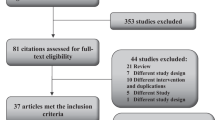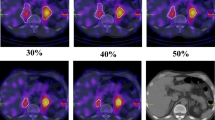Abstract
Objective
The purpose of the study was to evaluate the hypothesis that patients having a vasovagal reaction (VVR) after blood vessel puncture show increased FDG accumulation in bilateral adrenal glands.
Methods
Over the past 8 years, 26 patients experienced a VVR after blood vessel puncture following intra-venous injection of FDG at our institution. Of the 26 patients, 16 underwent multiple-occasion FDG-PET/CT scans while suffering a VVR at only one examination. All 16 patients had no morphological abnormality in the adrenal glands on FDG-PET/CT and follow-up examination. For the 16, we retrospectively reviewed the FDG-PET/CT scan with respect to the adrenal glands and compared the result to that for the FDG-PET/CT scan of the same patient when there was no VVR event. We used both visual analysis and semi-quantitative analysis employing either maximum standardized uptake value (SUVmax) or adrenal-to-liver (A/L) SUVmax ratio.
Results
On visual analysis of the FDG-PET/CT with VVR, accumulations in both of the adrenal glands was judged positive, defined as higher than the hepatic accumulation, in 84 % of the cases. The SUVmax in the right adrenal gland was 2.79 ± 0.69 with VVR and 1.92 ± 0.33 without VVR; this value in the left adrenal gland was 3.07 ± 0.71 with VVR and 2.05 ± 0.39 without. Mean SUVmax of both adrenal glands was 2.93 ± 0.66 with VVR and 1.98 ± 0.35 without. The A/L SUVmax ratio in the right adrenal gland was 1.02 ± 0.26 with VVR and 0.69 ± 0.11 without; this value in the left was 1.11 ± 0.23 with VVR and 0.74 ± 0.15 without. The mean A/L SUVmax ratio of both adrenal glands was 1.06 ± 0.24 with VVR and 0.72 ± 0.13 without. Each parameter with VVR was significantly higher than that without. For the two adrenal glands, the mean SUVmax with VVR was 48 % higher than that without VVR.
Conclusions
We confirmed the hypothesis that patients having a VVR after blood vessel puncture show increased FDG accumulation in their bilateral adrenal glands. This may reflect hyper-metabolism of the adrenal glands in synthesizing and secreting catecholamine.



Similar content being viewed by others
References
Rohren EM, Turkington TG, Coleman RE. Clinical applications of PET in oncology. Radiology. 2004;231:305–32.
Miller JC, Fischman AJ, Aquino SL, Blake MA, Thrall JH, Lee SI. FDG-PET CT for tumor imaging. J Am Coll Radiol. 2007;4:256–9.
Zhu A, Shim H. Current molecular imaging positron emitting radiotracers in oncology. Nucl Med Mol Imaging. 2011;45:1–14.
Han A, Xue J, Hu M, Zheng J, Wang X. Clinical value of 18F-FDG PET-CT in detecting primary tumor for patients with carcinoma of unknown primary. Cancer Epidemiol. 2012;36:470–5.
Gilchrist PT, Ditto B. The effects of blood-draw and injection stimuli on the vasovagal response. Psychophysiology. 2012;49:815–20.
Jinguji M, Nakajo M, Nakajo M, Nakabeppu Y, Yoshiura T. Vasovagal-related stress immediately before FDG injection may increase bilateral adrenal FDG uptake. Br J Radiol. 2016;89:20150950.
Wiersum-Osselton JC, Marijt-van der Kreek T, Brand A, Veldhuizen I, van der Bom JG, de Kort W. Risk factors for complications in donors at first and repeat whole blood donation: a cohort study with assessment of the impact on donor return. Blood Transfus. 2014;12:28–36.
Gonçalez TT, Sabino EC, Schlumpf KS, Wright DJ, Leao S, Sampaio D, et al. Vasovagal reactions in whole blood donors at three REDS-II blood centers in Brazil. Transfusion. 2012;52:1070–8.
Alboni P, Dinelli M, Gruppillo P, Bondanelli M, Bettiol K, Marchi P, et al. Haemodynamic changes early in prodromal symptoms of vasovagal syncope. Europace. 2002;4:333–8.
Fucà G, Dinelli M, Suzzani P, Scarfò S, Tassinari F, Alboni P. The venous system is the main determinant of hypotension in patients with vasovagal syncope. Europace. 2006;8:839–45.
Ermis C, Samniah N, Lurie KG, Sakaguchi S, Benditt DG. Adrenal/renal contribution to circulating norepinephrine in posturally induced neurally mediated reflex syncope. Am J Cardiol. 2003;91:746–50.
Lam KY, Lo CY. Metastatic tumours of the adrenal glands: a 30-year experience in a teaching hospital. Clin Endocrinol (Oxf). 2002;56:95–101.
Kumar R, Xiu Y, Yu JQ, Takalkar A, El-Haddad G, Potenta S, et al. 18F-FDG PET in evaluation of adrenal lesions in patients with lung cancer. J Nucl Med. 2004;45:2058–62.
Kim BS, Lee JD, Kang WJ. Differentiation of an adrenal mass in patients with non-small cell lung cancer by means of a normal range of adrenal standardized uptake values on FDG PET/CT. Ann Nucl Med. 2015;29:276–83.
Cho AR, Lim I, Na II, du Choe H, Park JY, Kim BI, et al. Evaluation of Adrenal Masses in Lung Cancer Patients Using F-18 FDG PET/CT. Nucl Med Mol Imaging. 2011;45:52–8.
Author information
Authors and Affiliations
Corresponding author
Ethics declarations
Conflict of interest
The authors have no conflict of interest to disclose with respect to this work.
Rights and permissions
About this article
Cite this article
Otomi, Y., Shinya, T., Otsuka, H. et al. Increased 18F-fluorodeoxyglucose accumulation in bilateral adrenal glands of the patients suffering from vasovagal reaction due to blood vessel puncture. Ann Nucl Med 30, 501–505 (2016). https://doi.org/10.1007/s12149-016-1088-5
Received:
Accepted:
Published:
Issue Date:
DOI: https://doi.org/10.1007/s12149-016-1088-5




